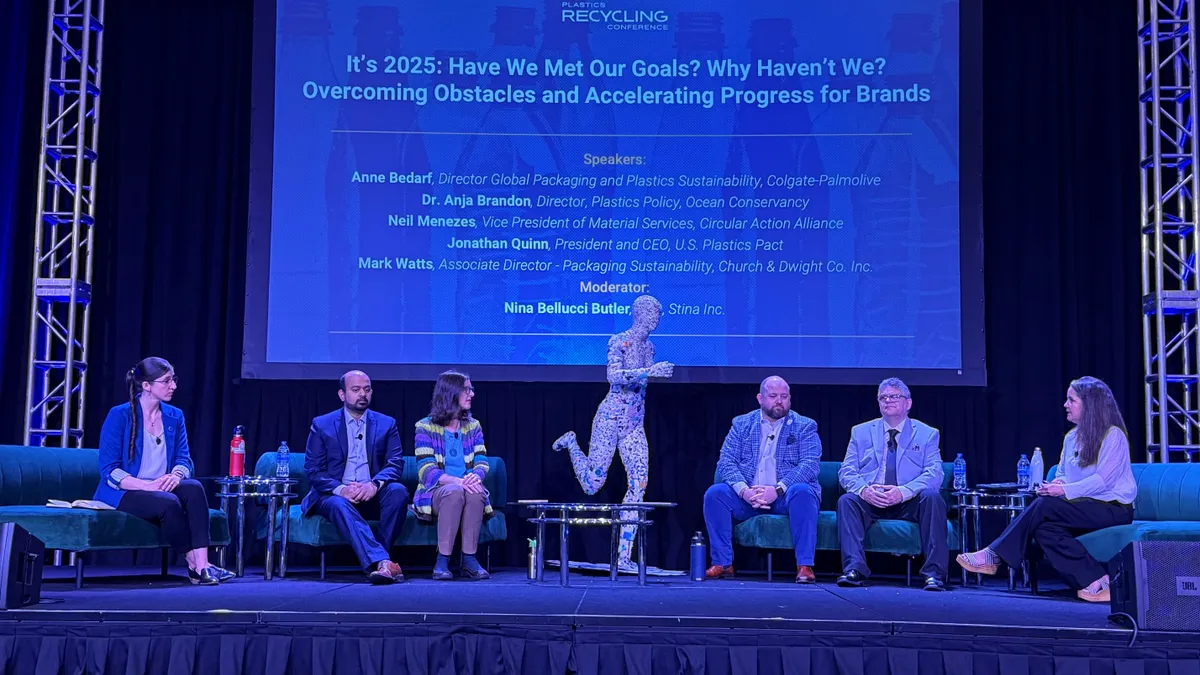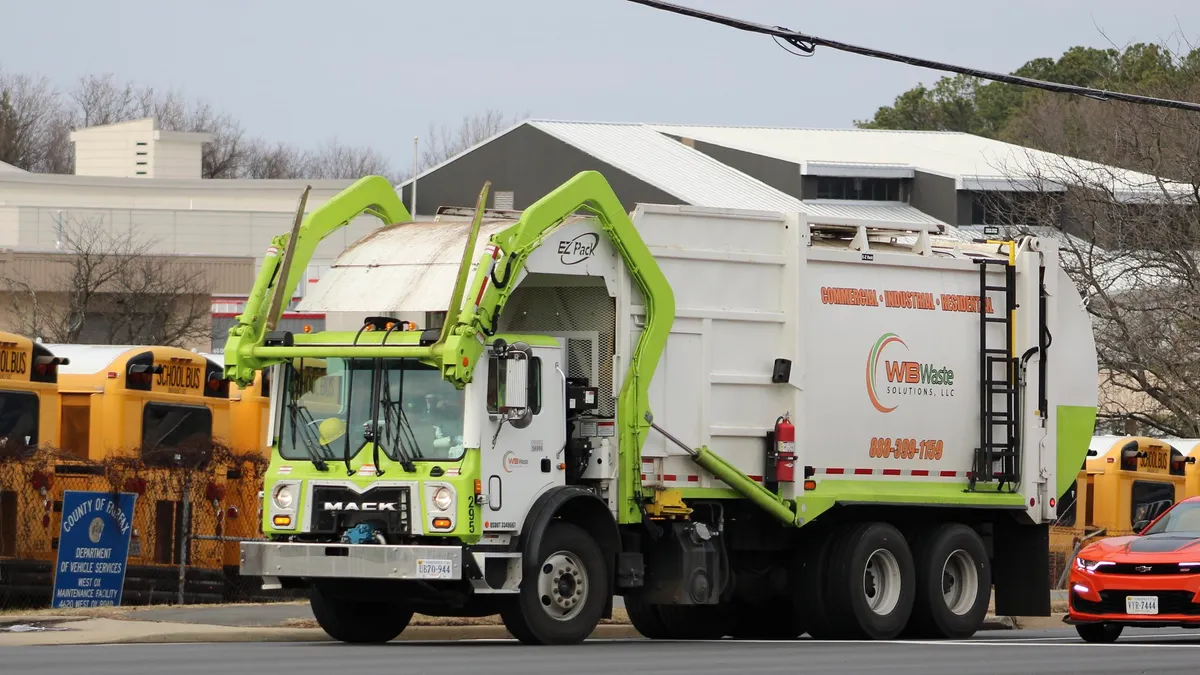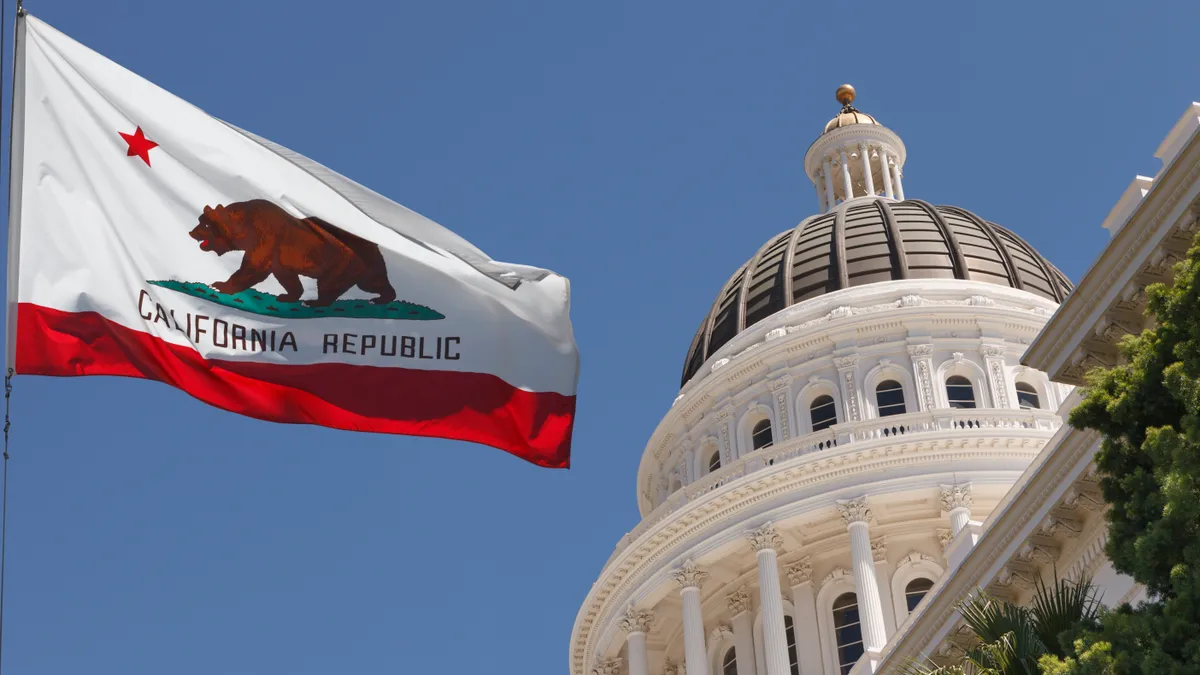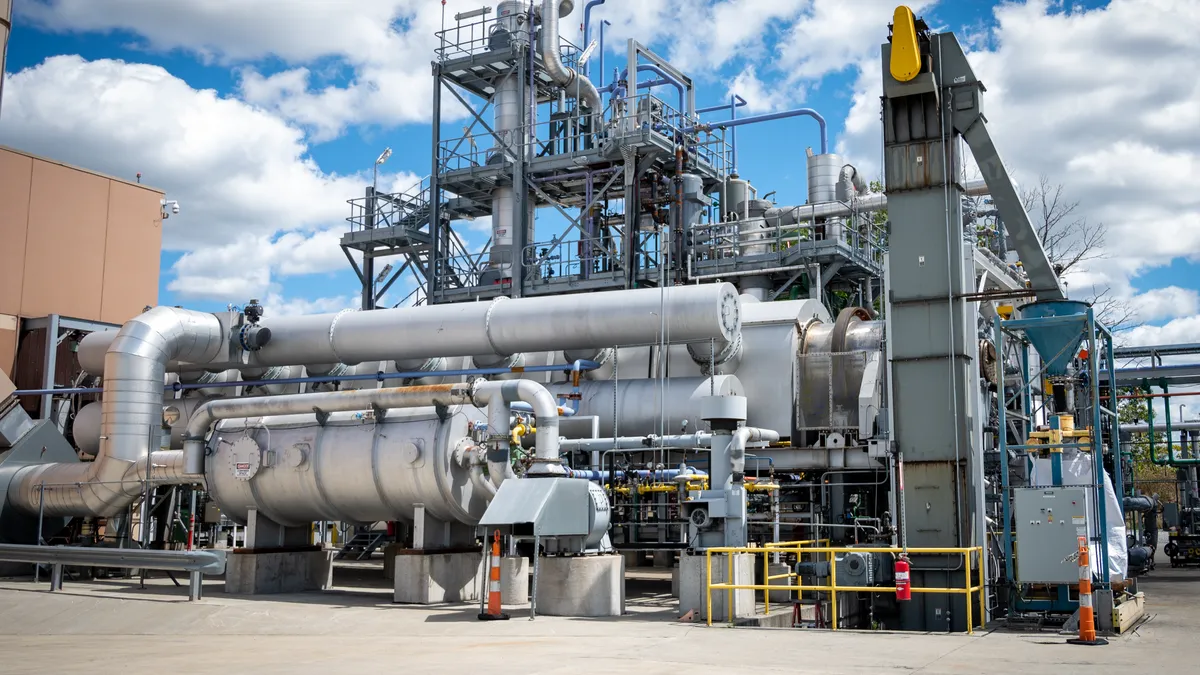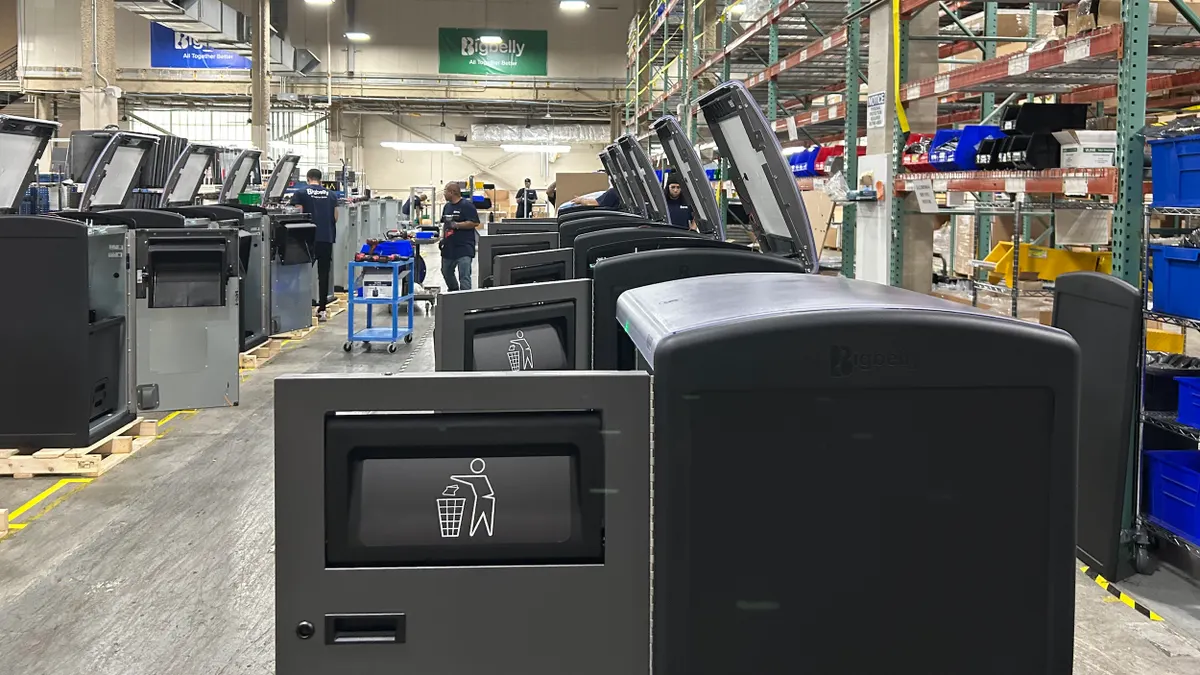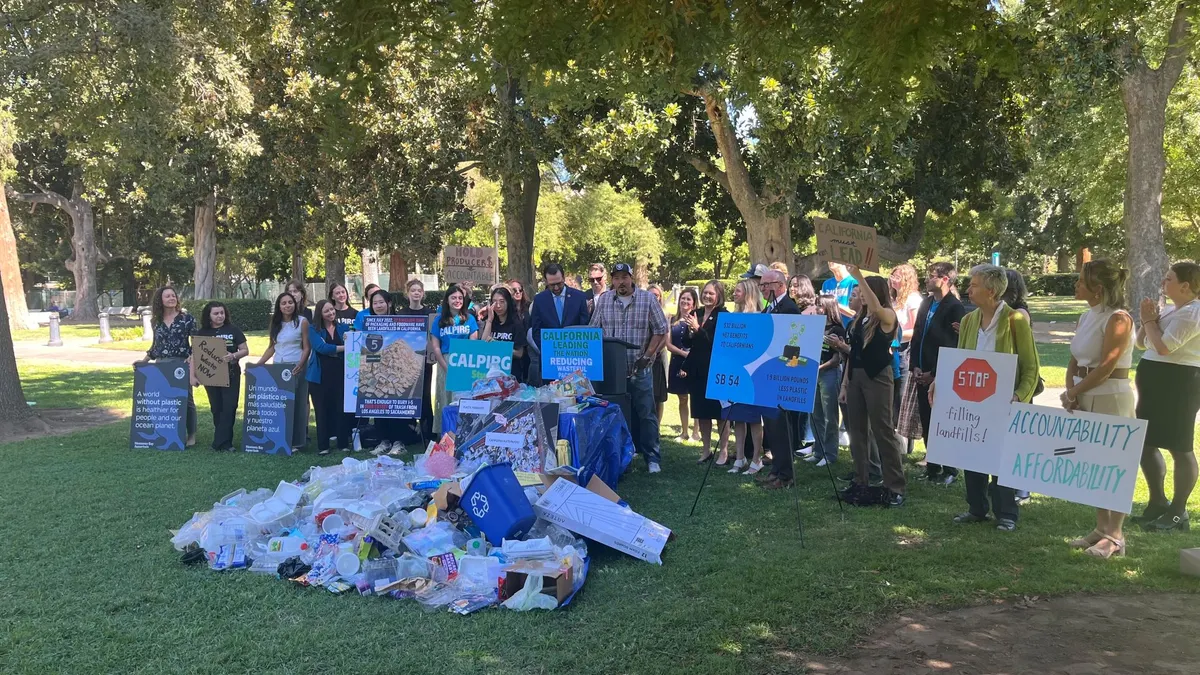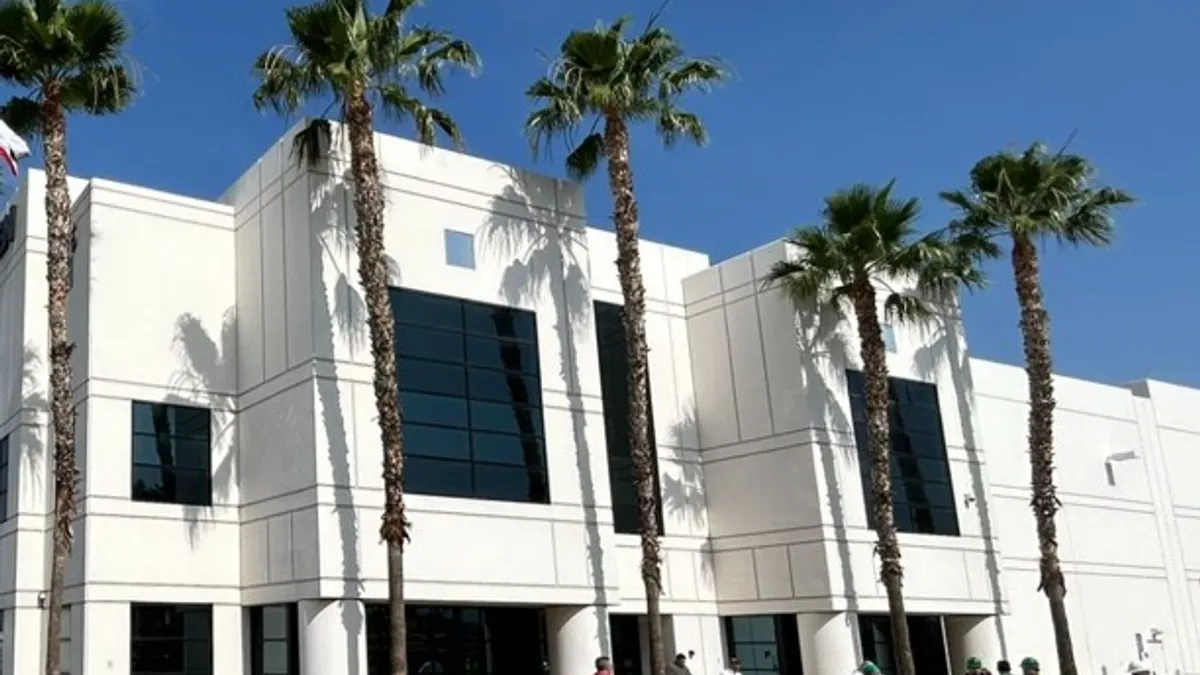The effort to add more recycled content to packaging has been a long road for brands, converters and recyclers alike. Speakers at last week’s Plastics Recycling Conference celebrated industry progress while highlighting the best next steps for improvement.
The conference, held March 24-26 in National Harbor, Maryland, highlighted ongoing supply and demand challenges, the role of brand commitments and the ups and downs of tackling harder-to-recycle packaging formats. Here are some takeaways from the event:
Balancing ambitious goals with business realities
Numerous brands have publicly committed to recycled content goals, and speakers highlighted the balancing act of striving toward ambitious targets while also being realistic — and transparent — when companies fall short of those goals.
Some brands that had 2025 deadlines as part of global commitment programs led by the U.S. Plastics Pact and the Ellen MacArthur Foundation either missed those targets or updated their timelines to 2030. USPP has also updated its strategic plan with new 2030 goal targets. A 2024 progress report from EMF noted that PCR now accounts for 14% of brand and retail signatories’ plastic packaging, which is up from 5% in the baseline year of 2018 but below the 2025 target of 26%.
Consumers ultimately need to understand the value of recycled content so they’re motivated to recycle, but they also need to understand the forces at work that make adding PCR difficult, such as market dynamics and supply challenges, said Jonathan Quinn, CEO of the U.S. Plastics Pact, during a panel on recycled content goals.
“As an industry, we've done a tremendous job of telling each other how great of an impact we're having, but we've done a horrible job of communicating the challenges and the hurdles of the progress we've made to consumers,” he said.
Mark Watts, associate director of packaging sustainability at Church & Dwight, noted during the panel that brand owners are grappling with the costs of adding PCR to their products, either because the PCR version of a resin is more expensive or because of added costs associated with certifying such PCR resins.
“It’s getting more and more expensive, as well as technically demanding, in terms of how we put this material back into products,” he said.
Watts says some companies face a “vicious spiral” where they scramble to meet higher recycled content rates by certain dates, “but the infrastructure is not keeping up with it, and we're now having to pay more for what little material is available that fits the portfolio.”
Brands must acknowledge the realities that make recycled content integration a challenge, but should continue making as many changes as they can — even if they miss a goal in the short term, Quinn said.
“We can’t back down now,” he said. “These goals are meant to be aspirational. If they’re not, they're not going to drive progress.”
Matching recycling policy with market demands
Upcoming extended producer responsibility laws for packaging could help smooth out many packaging companies’ supply and infrastructure problems, speakers said. However, EPR isn’t a magic wand — and EPR won’t have an immediate impact on markets or companies’ ability to integrate more recycled content.
“The beauty with EPR is that we can now go out to recyclers, municipalities and really invest in these [recycling] systems, knowing brands have your back” and will commit to buying recycled content in the long term, said Anja Brandon, director of plastics policy for the Ocean Conservancy. “In theory, that should be helping you, not tomorrow, but in three to five years, to get to those PCR goals, get to those targets.”
But policy — either EPR or other legislation — should also include PCR requirements that drive demand, she added. Without PCR mandates, recyclers don’t have assurances that customers will buy recycled content and could lag on investing in the infrastructure needed to do so.
Domestic sourcing is another key element to effective recycling legislation, Quinn added. “You’re getting access to all the material in the domestic market in which you operate. … That is critical to just making this financially viable,” he said.
Though most of these conversations are playing out at the state level, federal policy could also drive recycling and recycled content policy in coming years.
A newer perspective on recycling-related legislation is the idea that recycling supports the U.S. economy, a view that has become more popular under the Trump administration, said Kate Bailey, chief policy officer at the Association of Plastic Recyclers, during a panel on recycling policy. “It’s a more important time than ever to talk about the domestic manufacturing benefits of recycling,” she said.
In Congress, recycling has typically been seen as a bipartisan issue, even after the Trump administration took office again earlier this year, she said.
Investing in recycled content innovations
State and federal policies will continue to have an important influence over the future of recycled content in packaging, speakers said. Yet businesses also continue working on innovations meant to ease recycled content challenges.
Films and flexible packaging are formats that have endured such well-known challenges.
“In the big push to increase plastic recycling, the last one to be resolved will be film because it’s the hardest to do,” said Scott Coleman, CEO of Revolution Sustainable Solutions. The material is fragile, gets contaminated easily and often comes with a host of layers and additives that are expensive to eliminate, “but this still needs to be done — 18 billion pounds of film are manufactured or used in North America each year,” he said.
Part of getting brands on board with recycled content for these formats is acknowledging both the costs and the benefits, said Anna Rajkovic, market and innovation manager of mechanical recycling for Nova Chemicals.
“In our conversations with our converters, brand owners and retailers, everyone is interested in having the ability to put recycled content back in their products. And that means focusing on the high-quality products,” she said. “They are willing to pay for that quality, and that is a positive sign for our investments. That means we can drive innovation.”
Plastic film recycling is growing, although the sector still largely relies on recycled content from postindustrial sources and has limited curbside recycling inputs, speakers said.
“It’s in a place I never thought possible 10 years ago,” said Sunil Bagaria, chairman of film recycler GDB International. He noted that the company has grown its film recycling partnerships over the years, including with companies like General Mills.
Panelists noted that there’s also plenty of room for innovation in the food-grade plastics space, both for flexible packaging and for rigid polypropylene.
During a discussion on food-grade PP challenges, Neil Darin, senior director of resiliency and holistic packaging for TMS, noted that the resin offers packaging companies “great performance with great density advantage,” but uneven recycling markets mean finding reliable PCR sources can be a struggle.
Robert Flores, senior vice president of sustainability for Berry Global, noted that increased recycling rates for PP benefit both recyclers and packaging companies like his. That’s because a higher volume of PP allows customers to request specific grades and formats to fit their processes, he said.
Recycling equipment innovations are swiftly bridging the gap between sorting challenges and demand for PP that can easily be remade into food-grade resins, Darin said. “AI is something that we weren't even talking about a few years ago. Now, it’s being used to sort food grade from non-food grade.”
This story first appeared in the Waste Dive: Recycling newsletter. Sign up for the weekly emails here.



